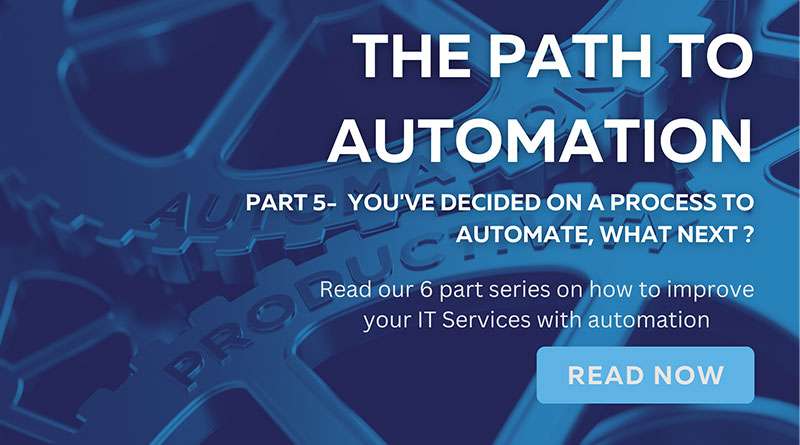The Path to Automation, part 5: We’ve picked one. What do we do next?
So, you’ve reviewed your data and made a decision on what to automate first. Brace yourself: now it’s time to put into action everything you’ve planned.
How you come at the project will naturally vary, depending on what you’re trying to automate, the budget you have available and the tool you pick. The people responsible for planning the work should have covered most of the technical and process elements early on in the discovery stage (see part 4), when you were deciding which request would be most beneficial to automate.
If you’re working through a relatively simple automation task, and have people on the team with experience in automation, then this phase shouldn’t be too tricky. The bigger challenges come with the more complex automation pieces that may require input from either a technical or a process specialist – or in some cases, both.
When organisations attempt to take on complex automation projects themselves, they tend to look at it form a pure technology standpoint and can often miss how import the process side of the equation is. Or they don’t realise there’s a more efficient way to implement what they’re trying to automate.
We’ve seen numerous projects hit difficulties weeks or months down the line when these kinds of issues start to crop up, or if you want to make a slight change to the process and realise you need to redevelop their existing implementation.
This is not to say that simple automation processes will always run smoothly. It’s just the impact of things going wrong is usually a lot more manageable and can often get fixed on the fly whenever an issue is reported.
This is why we believe it’s important to seek the advice of experts for a lot of the automation projects you take on, even if it’s just to plan the process and technical requirements for your technical teams to implement.
We’ll be able to help you avoid the many pitfalls that come with a project like this, and can also help you look at it from a broader perspective. For example, what happens if the project fails? What’s the fall-back plan? And what might be the effects – both positive and negative – on the wider business?
We’ll also be able to bring the technological expertise of integrating multiple tools and the in-depth knowledge of APIs that requires.
Above all, choosing the right toolset is important. For something simple like password resets, you can go for a cheap option. But, often, you’re likely to find yourself coming unstuck at some point.
If you possibly can, it’s better not to limit yourself based on cost. It’s also worth looking further down the line at what other processes you’ll be hoping to automate in the future and picking a tool that’s appropriate for those also. This, ultimately, can lead to savings in budget and effort in the long run.
Another route that organisations sometimes take is to not necessarily to use an off-the-shelf tool, but to write the code internally and automate a process through the tools you already have. But this can often be risky and take up a lot of time unnecessarily. By comparison, a tool like Kelverion, which integrates easily with most commonly-used office software, can often give you a better solution that’s also faster to implement.
And having that quick win with your first automation project is often crucial. It helps to get both your internal stakeholders and your customers onside – as, frequently, if they can’t immediately see the benefit, they’re likely to ignore it completely and keep on calling or emailing.
It’s also essential not to try to do too much at once. Whatever you do, stick with one process at a time. We know from experience that if you do that – perhaps one a month – you’ll get much further in the long run than if you try to do everything at once. It’s far better to deliver one small, successful project at a time than find out in six months you’ve only achieved half of what you set out to do because you’ve overstretched.
And once that first process is automated, it’ll soon be time to evaluate it and – hopefully – move on to the next one. Click here to read the next article in our series.
This is part 5 in our series of articles about automation. To start at the beginning, click here.
We hope you’ve found this useful. If you do, please get in touch for a no-strings chat about how we can help your organisation reap the benefits of automation.



